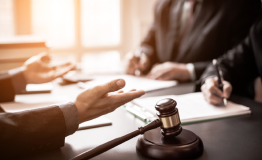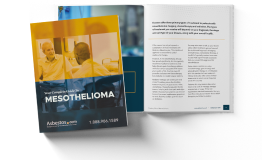Asbestos in South Dakota
Asbestos is not particularly widespread in South Dakota, but it continues to pose health threats to the state's residents. Although South Dakota's largest economic sectors — tourism, services and agriculture — are not strongly associated with asbestos exposure, any building materials or products containing the mineral can release dangerous airborne fibers if disturbed.

Written by Matt Mauney | Scientifically Reviewed By Arti Shukla, Ph.D. | Edited By Walter Pacheco | Last Update: July 17, 2024
Asbestos Exposure in South Dakota
Several natural deposits of asbestos can be found near South Dakota’s western border with Wyoming. A second mineral similar to asbestos also occurs naturally in some locations throughout the state putting surrounding populations at risk for developing mesothelioma and other respiratory illnesses.
Compared to most other states, South Dakota has far fewer cases of asbestos exposure. The state ranks 41st in the country for mesothelioma and asbestosis deaths, with a total of 91 deaths from asbestos-related illnesses from 1999 to 2013. This number dwarfs in comparison to other states where thousands of deaths have been attributed to asbestos exposure during the same time period.
Anyone who inhales airborne asbestos fibers is at risk for serious respiratory illnesses including mesothelioma, asbestosis and lung cancer. For those in South Dakota burdened by an asbestos-related disease, the state has several medical facilities that provide treatment options.
Asbestos exposure remains a threat throughout older buildings and job sites in South Dakota. For example, in April 2021, members of the Mitchell City Council met to discuss approval of an asbestos removal project at an uninhabitable property in downtown Mitchell, South Dakota. The building has asbestos-contaminated siding and other materials that will cost more than $15,000 to remove before demolition of the building can proceed.

Learn about your diagnosis, top doctors and how to pay for treatment.
Get Your Free GuideSouth Dakota’s Occupations and Environmental Areas at Risk
Even with a relatively low number of asbestos-related deaths in South Dakota, certain occupations put workers at risk for dangerous levels of asbestos exposure. For example, workers at any of the state’s four hydroelectric power plants could be at risk for asbestos-related disease. These power plants use mechanical components called turbines that often contain asbestos. Power plant employees who work with these turbines could inhale toxic asbestos fibers if they become airborne.
Mechanics at any of South Dakota’s auto repair facilities are also regularly at risk for asbestos exposure. Asbestos is commonly used in vehicles to prevent friction, specifically in brake and clutch components. Workers who handle these parts may inhale asbestos fibers. Asbestos exposure has historically been most prevalent in industrial, manufacturing and construction sectors. Aging industrial machinery containing asbestos insulation has been known to deteriorate and release fibers over time. Several other occupations in South Dakota are associated with an increased risk of asbestos exposure, though documented cases may not have been reported.
These occupations include:
- Construction workers
- Industrial engineers
- Mechanics
- Military personnel
- Insulation contractors
- Police officers
- Power plant workers
- Teachers
Deposits of asbestos also form naturally in one specific area of western South Dakota. A close group of deposits can be found just miles south of Mount Rushmore in Keystone. These include occurrences at Homestake Gold Mine, Iron Mountain, one unnamed former asbestos prospect and near Jewell Cave National Monument. Environmental exposure to asbestos does not usually pose health threats, but if deposits are disturbed through mining or other human activities, asbestos fibers can become airborne and affect the health of surrounding populations.
South Dakota landfills permitted to accept asbestos-containing waste could cause environmental exposure to asbestos as well. These facilities include:
- Belle Fourche Landfill, 606 6th Ave., Belle Fourche, SD 57717
- Brookings Landfill, P.O. Box 270, Brookings, SD 57006
- Brown County Landfill, 13225 379th Ave., Aberdeen, SD 57402
- Roberts County Landfill, Rural Route 2, Box 1, Sisseton, SD 57262
- Sioux Falls Landfill, 224 W. 9th St., Sioux Falls, SD 57117
- Southern Missouri Landfill, P.O. Box 146, Lake Andes, SD 57356
- Tri-County Landfill, Rural Route 1, Box 159 D, Pukwana, SD 57370
- Mitchell Landfill, 612 N. Main St., Mitchell, SD 57301
- Pierre Landfill, 2800 E. Park St., Pierre, SD 57501
- Rapid City Landfill, 300 6th St., Rapid City, SD 57701
- Vermillion Landfill, 25 Center St., Vermillion, SD 57069
- Walworth County Landfill, P.O. Box 242, Selby, SD 57472
- Watertown Landfill, P.O. Box 910, Watertown, SD 57201
Job Sites with Known Asbestos Exposure
- Stanley County Elementary School
- Belle Fourche Police Headquarters
- Homestake Gold Mine
Ellsworth Air Force Base
Ellsworth Air Force Base, located near the city of Box Elder, is South Dakota’s second largest employer. Before the dangers of asbestos were well-known, United States military facilities made extensive use of the material for insulation and fire resistance purposes. Asbestos can be found throughout the Ellsworth Air Force Base’s numerous buildings, weapons, vehicles and housing. Despite the Air Force’s efforts to eliminate exposure through asbestos management plans, years of constant exposure likely occurred, placing service personnel at risk for asbestos-related diseases.
This Page Contains 8 Cited Articles
The sources on all content featured in The Mesothelioma Center at Asbestos.com include medical and scientific studies, peer-reviewed studies and other research documents from reputable organizations.
- Fosness, S. (2021, April 4). Mitchell City Council to consider asbestos removal agreement for downtown nuisance building. Retrieved from https://www.mitchellrepublic.com/news/mitchell-city-council-to-consider-asbestos-removal-agreement-for-downtown-nuisance-building
- Cool, L.C. (2011, August 16). Driving is the New Cancer. http://health.yahoo.net/experts/dayinhealth/driving-new-cancer-risk
- Dailey, M. (2011). Former city employees files lawsuit. http://rapidcityjournal.com/buttecountypost/news/former-city-employee-files-lawsuit/article_0c998432-8e44-5e8b-9088-6c3bbbe08fab.html
- Federal Mine Safety & Health Review Commission. (1989). MSHA v. FMC Wyoming Corporation. http://www.fmshrc.gov/decisions/commission/89091622.pdf
- Gamble, J. (2005). An Evaluation of the Risks of Lung Cancer and Mesothelioma from Exposure to Amphibole Cleavage Fragments. http://www.msha.gov/regs/comments/05-14510/ab24-comm-110-4.pdf
- Nealon, C. (2011). Asbestos: At least 12 contractors exposed at Surry reactor. http://articles.dailypress.com/2011-10-22/news/dp-nws-cp-asbestos-surry-20111022_1_surry-reactor-pipe-fitters-asbestos-warning/2
- Reha, B. (2005). South Dakota's Ellsworth AFB to stay open. http://news.minnesota.publicradio.org/features/2005/08/26_rehab_ellsworthopen/
- Centers for Disease Control and Prevention, National Center for Health Statistics. (2015, January). Underlying Cause of Death 1999-2013 on CDC WONDER Online Database. http://wonder.cdc.gov/ucd-icd10.html







